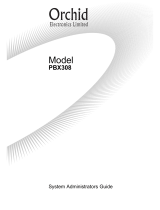
2.6.8 Utility—Error Log ............................................................................................................77
2.6.9 Utility—T1/E1 Signalling Bit Monitor ...............................................................................79
2.6.10
Utility—T1/E1 Line Trace ...............................................................................................80
2.6.11 Utility—ISDN/QSIG Protocol Trace ................................................................................81
2.6.12 Utility—V-IPGW16 Protocol Trace .................................................................................82
2.6.13 Utility—Digital Trunk Error Report ..................................................................................83
2.6.14 Utility—IP Extension Statistical Information ...................................................................84
2.6.15 Utility—CS Information ...................................................................................................85
2.6.16 Utility—PS Information ...................................................................................................86
2.6.17 Utility—Ping ....................................................................................................................87
2.6.18 Utility—Timed Update ....................................................................................................88
2.6.19 Utility—System Reset—Reset by the Command ...........................................................89
2.6.20 Utility—Flash ROM ID Information .................................................................................91
2.7 Help ..................................................................................................................................92
2.7.1 Frequently Asked Questions (FAQ) ...............................................................................92
3 [1] Configuration ..................................................................................103
3.1 [1-1] Slot .........................................................................................................................104
3.2 [1-1] Slot—Summary .....................................................................................................109
3.3 [1-1] Slot—Activation Key ............................................................................................114
3.4 [1-1] Slot—Card Property - IPCMPR ............................................................................117
3.5 [1-1] Slot—OPB3 Card Property ..................................................................................134
3.6 [1-1] Slot—OPB3 Card Property—Card Command ....................................................137
3.7 [1-1] Slot—Port Property - Virtual IP Gateway Port ...................................................138
3.8 [1-1] Slot—Port Property - Virtual IP Gateway Port—Connection Command .........140
3.9 [1-1] Slot—Shelf Property - Virtual IP Gateway ..........................................................141
3.10 [1-1] Slot—Shelf Property - Virtual IP Gateway—GK Settings ..................................165
3.11 [1-1] Slot—Shelf Property - Virtual IP Gateway—GW Settings .................................166
3.12 [1-1] Slot—Shelf Property - Virtual IP Gateway—DN2IP ............................................173
3.13 [1-1] Slot—Shelf Property - Virtual IP Gateway—Hunt Pattern .................................175
3.14 [1-1] Slot—Card Property - Virtual IP Extension ........................................................176
3.15 [1-1] Slot—Port Property - Virtual IP Extension .........................................................183
3.16 [1-1] Slot—Port Property - Virtual IP Extension—Connection Command ...............192
3.17 [1-1] Slot—Card Property - Virtual SIP Extension ......................................................193
3.18 [1-1] Slot—Port Property - Virtual SIP Extension Port ...............................................197
3.19 [1-1] Slot—Port Property - Virtual SIP Extension Port—Connection
Command .......................................................................................................................202
3.20 [1-1] Slot—Card Property - Extension Type ...............................................................203
3.21 [1-1] Slot—Port Property - Extension Port ..................................................................209
3.22 [1-1] Slot—Port Property - Extension Port—Connection Command ........................217
3.23 [1-1] Slot—Port Property - Extension Port—Port Type View ....................................218
3.24 [1-1] Slot—Port Property - CSI/F Port ..........................................................................219
3.25 [1-1] Slot—Port Property - CSI/F Port—Connection Command ................................222
3.26 [1-1] Slot—Card Property - LCO type ..........................................................................223
3.27 [1-1] Slot—Port Property - LCO Port ...........................................................................236
3.28 [1-1] Slot—Port Property - LCO Port—Connection Command .................................242
3.29 [1-1] Slot—Card Property - BRI type/PRI type ............................................................243
3.30 [1-1] Slot—Port Property - BRI Port .............................................................................258
3.31 [1-1] Slot—Port Property - BRI Port—Connection Command ...................................283
3.32 [1-1] Slot—Port Property - PRI Port .............................................................................284
3.33 [1-1] Slot—Port Property - PRI Port—Connection Command ...................................306
3.34 [1-1] Slot—Card Property - T1 type .............................................................................307
3.35 [1-1] Slot—Port Property - T1 Port ...............................................................................318
3.36 [1-1] Slot—Port Property - T1 Port—Connection Command .....................................327
3.37 [1-1] Slot—Card Property - E1 type .............................................................................328
6 PC Programming Manual
Table of Contents




















